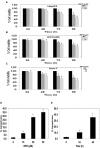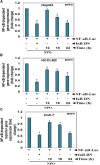N-Substituted Pyrido-1,4-Oxazin-3-Ones Induce Apoptosis of Hepatocellular Carcinoma Cells by Targeting NF-κB Signaling Pathway
- PMID: 30455641
- PMCID: PMC6230568
- DOI: 10.3389/fphar.2018.01125
N-Substituted Pyrido-1,4-Oxazin-3-Ones Induce Apoptosis of Hepatocellular Carcinoma Cells by Targeting NF-κB Signaling Pathway
Abstract
Hepatocellular carcinoma (HCC) is a fatal disease and ranked fifth in cancer related mortality. Persistent activation of NF-κB is responsible for the oncogenesis, metastasis, tumor evasion, anti-apoptosis, angiogenesis and proliferation in HCC. Therefore, designing of chemically novel, biologically potent small molecules that target NF-κB signaling cascade have gained prominent clinical interest. Herein we synthesized a novel class of 4-(substituted)-2H-pyrido[3,2-b][1,4]oxazin-3(4H)-one by reacting 2H-pyrido[3,2-b][1,4]oxazin-3(4H)-one with various alkyl halides by using combustion derived bismuth oxide. We evaluated the antiproliferative efficacy of newly synthesized compounds against HCC cells and identified 4-(4-nitrobenzyl)-2H-pyrido[3,2-b][1,4]oxazin-3(4H)-one (NPO) as lead anticancer agent. In addition, we investigated the effect of NPO on the DNA binding ability of NF-κB and NF-κB regulated luciferase expression in HCC cells. The results demonstrated that NPO can induce significant growth inhibitory effects in HepG2, HCCLM3 and Huh-7 cells in dose and time-dependent manner. Interestingly, NPO induced significant downregulation in p65 DNA binding ability, p65 phosphorylation and subsequent expression of NF-κB dependent luciferase gene expression in diverse HCC cell lines. Further, in silico docking analysis suggested that NPO can show direct physical interaction with NF-κB. Finally, NPO was found to significantly abrogate tumor growth at a dose of 50 mg/kg in an orthotopic mouse model. Thus, we report the potential anticancer effects of NPO as a novel inhibitor of NF-κB signaling pathway in HCC.
Keywords: NF-κB; anticancer; apoptosis; hepatocellular carcinoma; oxazines.
Figures







References
-
- Aggarwal B. B., Harikumar K. B. (2009). Potential therapeutic effects of curcumin, the anti-inflammatory agent, against neurodegenerative, cardiovascular, pulmonary, metabolic, autoimmune and neoplastic diseases. Int. J. Biochem. Cell Biol. 41 40–59. 10.1016/j.biocel.2008.06.010 - DOI - PMC - PubMed
-
- Ahn K. S., Sethi G., Aggarwal B. B. (2007). Simvastatin potentiates TNF-alpha-induced apoptosis through the down-regulation of NF-kappaB-dependent antiapoptotic gene products: role of IkappaBalpha kinase and TGF-beta-activated kinase-1. J. Immunol. 178 2507–2516. 10.4049/jimmunol.178.4.2507 - DOI - PubMed
-
- Ananthula S., Parajuli P., Behery F. A., Alayoubi A. Y., El Sayed K. A., Nazzal S., et al. (2014). Oxazine derivatives of gamma- and delta-tocotrienol display enhanced anticancer activity in vivo. Anticancer Res. 34 2715–2726. - PubMed
LinkOut - more resources
Full Text Sources

